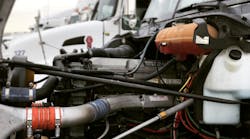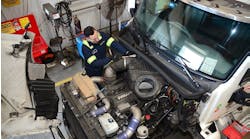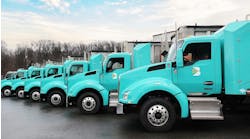I’ve been impressed so far with how thorough the instructors have been to educate incoming professional drivers for the trucking industry. At Waukesha County Technical College's professional truck driving program, every student must learn how to conduct a complete pre-trip inspection.
During the second week of the 10-week program, we first learned about the process of how to inspect the tractor and trailer before we get behind the wheel.
Our instructor, Jeff, covered every aspect of the inspection process, beginning with the vehicle overview, the engine compartment, all sides of the tractor and trailer, the kingpin and fifth wheel, and the cab. Not to mention, testing the air brakes with the LABS test (more on that later).
As an introduction to the pre-trip inspection process, we spent nearly two hours going through every aspect of the vehicle. And that first walkaround was like drinking from a firehose.
While a real-life pre-trip should take a driver about 15 minutes, testing for the pre-trip inspection portion of the CDL test requires the driver to provide details on every aspect of the vehicle he or she is checking. The test can take about 45 minutes. Steps include pointing to each component or system of the vehicle, and stating out loud specifically what we would look for to ensure there are no issues.
For instance, when inspecting under the hood you would look at the alternator and state, "this is the alternator, all nuts are securely fastened and it is securely mounted. The alternator is belt driven, so I will test the belt to confirm there is no more than a 1/2" of free play." You would then push in on the belt to indicate you're testing the free play of the belt. You continue this review and phrasing during the entire pre-trip inspection test.
Prepping for the CDL pre-trip inspection test
All students received a checklist to use for each pre-trip inspection while in class. The checklist has text single-spaced, front to back, and organized by area of the vehicle. It covers the following areas of the vehicle:
Engine compartment and front of tractor. A review all all components under the hood, including the critical fluids - power steering, engine oil, coolant and windshield washer fluid, as well as components such as the water pump, air compressor, alternator, the power steering linkage, etc. The driver must also review all aspects of the steer axle, including the suspension (typically leaf springs), brakes and tires.
Tractor side and rear. This covers a review of the sides and back of the tractor, including air hoses, exhaust and the catwalk. This also includes examining one drive axle, including the suspension, brakes and tires.
Trailer side and rear. A review of the trailer header board, the back trailer doors, and everything in between. This test also requires the review of one of the axles on the trailer tandems. Drivers must know how to inspect the suspension, brakes and tires.
Coupling device. While technically part of the tractor rear/trailer front inspection, the fifth wheel and kingpin have a separate checklist, which includes a review of the tractor portion (the fifth wheel/skid plate, slide locking pins and the pivot pin and release arm) as well as the trailer portion (the apron, or bottom of the trailer where the slide plate touches, and the the king pin).
Cab check and engine start. The cab check should begin with a "safe start" - meaning before the vehicle is turned on, the driver must check to confirm the seat belt is in proper working order, and not frayed or damaged; the vehicle is in neutral (here, you can also check the throws to confirm the distance for shifting); that there is about 1-2" of free play on the clutch; and that the parking brake is on (the red and yellow knobs are pulled out). Once the vehicle is turned on, the driver will check the windshield wipers, all gauges are in proper working order, that the heat and defrost work, and vehicle lights are all working. This includes headlights, high beams, turn signals, hazards, brake lights and clearance lights. This is also the time when you build air pressure for the air brakes, to complete the brake check.
Brake check. Drivers must have an understanding of the step-by-step process for ensuring all aspects of the air brake system are in proper working order. This is completed through the LABS test. (More on that in an upcoming blog.)
Safety equipment check. You must confirm the cab includes a full fire extinguisher, three safety triangles and electrical fuses.
At WCTC we have about 10 different vehicles to choose from when driving on the range or road, and they run the gamut when it comes to age, make and model, transmission speed, etc. While there are some common layouts under the hood (e.g. mostly - but not always - will you find the power steering pump and air compressor on the driver's side; and the alternator and water pump on the passenger's side), conducting a pre-trip on a different vehicle each time we drive allows students to understand the nuances and layout of each truck.
A thorough pre-trip needs to be done at the start of duty for the driver, before he or she operates the vehicle. This isn’t to mention en route and post-trip inspections. We'll now have the opportunity over the next seven weeks to put these skills to the test, by conducting a pre-trip inspection every time we get behind the wheel - whether that be for the closed range or on the road.
...
In the Driver’s Seat is a blog series from Fleet Maintenance editor-in-chief Erica Schueller. The series covers the process of attending a formalized technical training professional truck driving program in order to obtain a Class commercial vehicle driver’s license.
For more updates, follow her on Twitter and Instagram.




